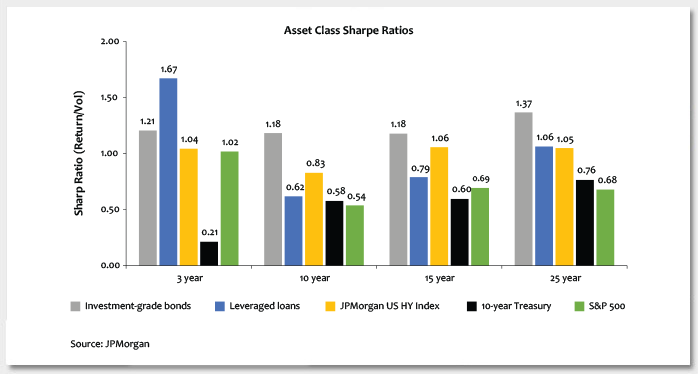Following another strong year in the risk markets and a robust start to the New Year, where to invest and how to allocate assets across markets has become a difficult decision. Valuations in the high yield bond market, in particular, always generate a lot of debate, with numerous market observers ready to declare the beginning of the end with every bout of volatility. While it is unsettling to be buying high yield credit and/or leveraged loans when spreads are at post-crisis tights, the chart above shows the merits of staying invested in these asset classes through the cycle. Market timing is challenging at best, and most, including myself, have proven to be lousy at it. I think the question isn’t whether to have an allocation to leveraged credit, but how to position within it from a quality and duration aspect – that in turn depends on one’s investment objectives and current fundamental and technical view.
According to JP Morgan, the high yield market has only registered five negative returning years since 1980 – and never in two consecutive years – implying that recession or exogenous led sell-offs have been relatively brief. Moreover, on a risk-adjusted basis (as measured by the Sharp Ratio), the high yield and leveraged loan markets have looked attractive versus other asset classes over the last 25 years. The almost 40-year secular decline in interest rates has benefited all risk markets, but most notably investment grade credit, which is longer duration in nature. In a rising rate scenario, assuming the rate rise is driven by improving global growth expectations, high yield bonds and loans will perform well relative to other fixed income asset classes. For example, year to date through Jan. 23, 10- and 30-year Treasury rates have increased about 20 and 15 basis points, respectively. Total returns on Bloomberg Barclays U.S. Aggregate Index was roughly negative 85 basis points while the Bloomberg Barclay’s High Yield Index returned positive 79 basis points.
Key TakeawayWhen the next downturn arrives, high yield corporate credit will get slammed, as will equities, leverage loans, structured risk product such as commercial mortgage backed securities and collateralized loan obligations, and anything else that carries default and liquidity risk. Trying to predict when and what the triggers will be is something we always debate as this business and credit cycle continues to defy gravity. Not included in this week’s chart, but a data point that informs my opinion, are the risk-adjusted returns by ratings category within the high yield market, which demonstrates that BB credit has materially higher risk-adjusted returns versus single B and CCC credit. For the most part, my thoughts are to stay up in quality, stay liquid, stay calm, and most importantly, stay invested!
The material provided here is for informational use only. The views expressed are those of the author, and do not necessarily reflect the views of Penn Mutual Asset Management.
This material is for informational use only. The views expressed are those of the author, and do not necessarily reflect the views of Penn Mutual Asset Management. This material is not intended to be relied upon as a forecast, research or investment advice, and it is not a recommendation, offer or solicitation to buy or sell any securities or to adopt any investment strategy.
Opinions and statements of financial market trends that are based on current market conditions constitute judgment of the author and are subject to change without notice. The information and opinions contained in this material are derived from sources deemed to be reliable but should not be assumed to be accurate or complete. Statements that reflect projections or expectations of future financial or economic performance of the markets may be considered forward-looking statements. Actual results may differ significantly. Any forecasts contained in this material are based on various estimates and assumptions, and there can be no assurance that such estimates or assumptions will prove accurate.
Investing involves risk, including possible loss of principal. Past performance is no guarantee of future results. All information referenced in preparation of this material has been obtained from sources believed to be reliable, but accuracy and completeness are not guaranteed. There is no representation or warranty as to the accuracy of the information and Penn Mutual Asset Management shall have no liability for decisions based upon such information.
High-Yield bonds are subject to greater fluctuations in value and risk of loss of income and principal. Investing in higher yielding, lower rated corporate bonds have a greater risk of price fluctuations and loss of principal and income than U.S. Treasury bonds and bills. Government securities offer a higher degree of safety and are guaranteed as to the timely payment of principal and interest if held to maturity.
All trademarks are the property of their respective owners. This material may not be reproduced in whole or in part in any form, or referred to in any other publication, without express written permission.


